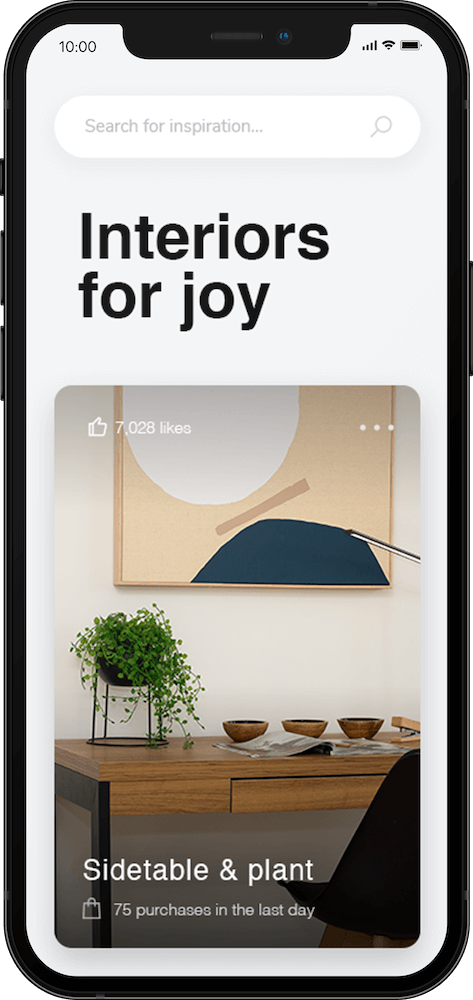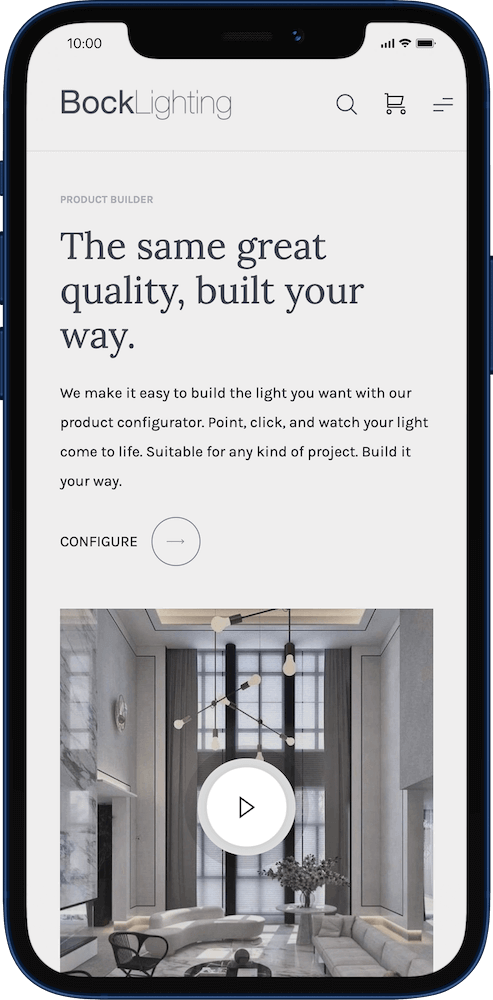
We Build Powerful, Integrated Commerce Solutions with Shopify
Rapid Headless Commerce development & implementation for Shopify.
High-performance Websites
We build lean, functional websites for high-availability & performance based on Headless Shopify.
Scalable Storefronts
Developing highly-scalable Headless Shopify storefronts & web applications for forward-thinking brands.
Builders & Configurators
Development of intuitive live product builders, visualizers & configurators for React-based Headless Shopify stores.
What We Do
Shopify frontend, application & integration developers.
Passionate about Driving Sales.
We develop scalable ecommerce sites & PWAs using Headless Shopify: for unparalleled speed, scalability and feature availability.
Headless as an Approach
By combining Shopify’s intuitive commerce management with high-performance Jamstack storefronts, we develop cutting-edge ecommerce stores that engage consumers and drive sales.
Intelligent Ecommerce with Shopify
Leveraging the unrivaled flexibility of Headless Shopify, we're driven to deliver intelligent solutions for the modern-day web. With automation, commerce logic, and recommender systems, we position user experience at the forefront of our focus.
What we do
We help brands build richer customer relationships with headless commerce
Headless commerce with Shopify
With a headless implementation, Shopify provides a powerful backend for management of products & payments, with an independent, decoupled storefront powered by modern JavaScript.
Decoupled Storefronts
Deliver impactful experiences through implementation of engaging storefronts and product configurators—using modern web application frameworks.
Headless Shopify Development
Leverage Shopify's robust platform for managing products & processing payments, without reinventing the wheel.
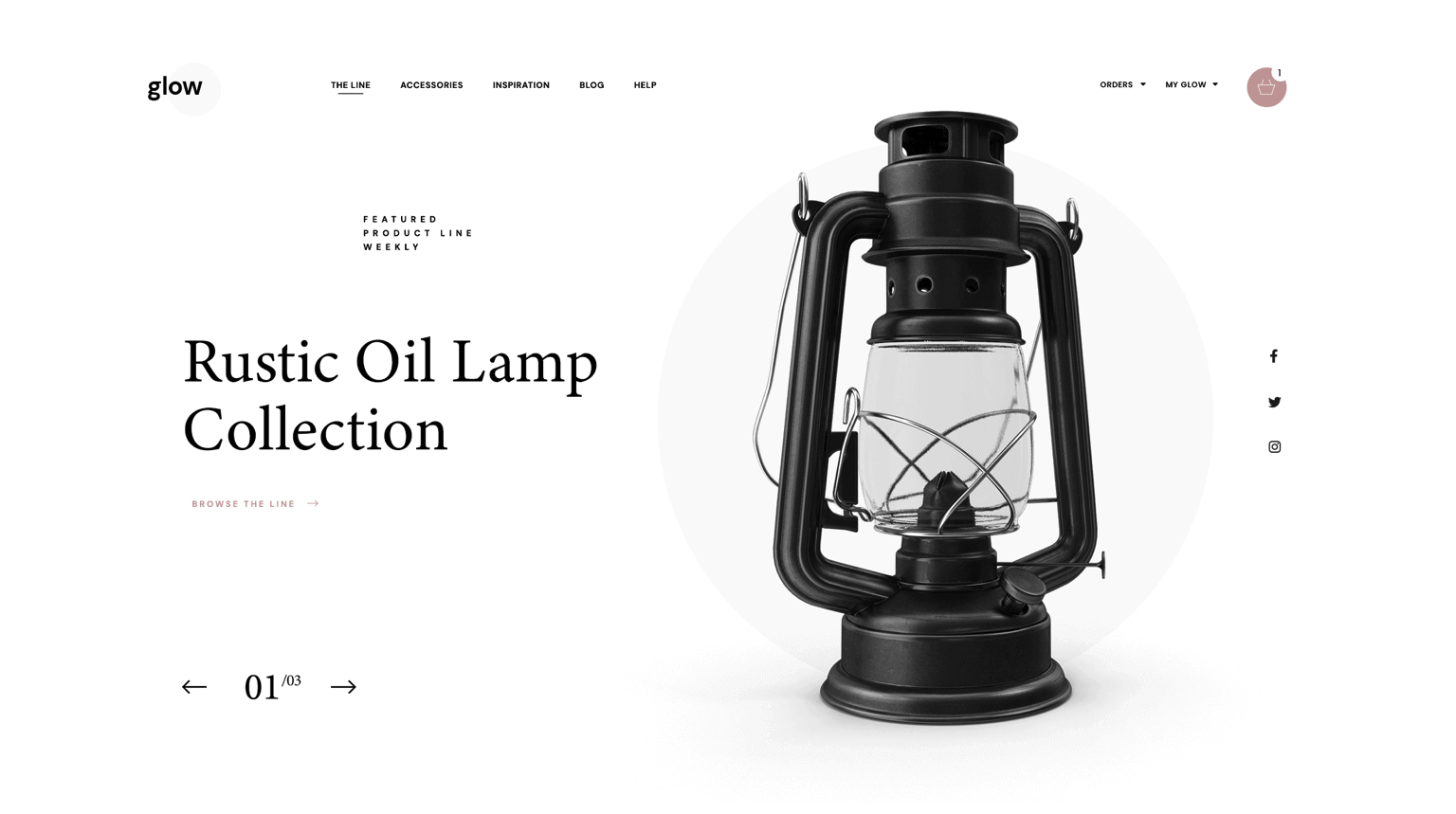
Game changing ecommerce solutions that deliver results
We strive to empower businesses to create greater impact. Through our passion for integrations and APIs, our developers architect end-to-end retail solutions leveraging Shopify.
Product Configurators
End-to-end development of custom product configurators & real-time builders.
Backend Automation
High-level automation for product, distribution & marketing workflows.
Data Synchronization
API-driven synchronization of complex content between Shopify & CMS.
Events & Communication
Communication & data exchange between Shopify and external applications.
Headless Shopify is Scalable
Infinitely scalable commerce architecture with Headless Shopify
At its core, Headless Shopify utilizes a Jamstack approach for codebase & services architect. The principles of Jamstack focus largely on performance and scalability. And as headless implementations generally follow the Jamstack approach, this can certainly be leveraged with headless Shopify.
The ability to scale is a fundamental part of application and infrastructure planning for the modern web, and nowhere is this as mission-critical as e-commerce. With a services-based headless setup, each individual component of the stack is scalable independently, providing greater levels of flexibility.
How it works
Why Headless Shopify?
Headless Shopify Developers
At Cocoon, we’re passionate about creating unparalleled headless commerce experiences using Shopify, applying everything we know to deliver a solution that drives sales.
Higher-level ecommerce with headless Shopify development
We develop intuitive ecommerce experiences with headless Shopify that are more connected, capable, and agile.
Deep Integrations
We help commerce-driven businesses achieve a deeper level of integration with third party software, CRMs and applications.
Automation for Operations
Through the implementation of automation, we build solutions that have the capacity to reduce overhead and streamline operations.
Recommender Systems
Deliver greater relevancy to consumers through powerful recommender systems that are tailored to your users' needs & behaviors.
Commerce Logic
Our headless Shopify developers build & integrate solutions for powerful commerce logic with headless Shopify, enabling greater control of product inventories.
What we do
Emotive, results-driven headless storefronts.
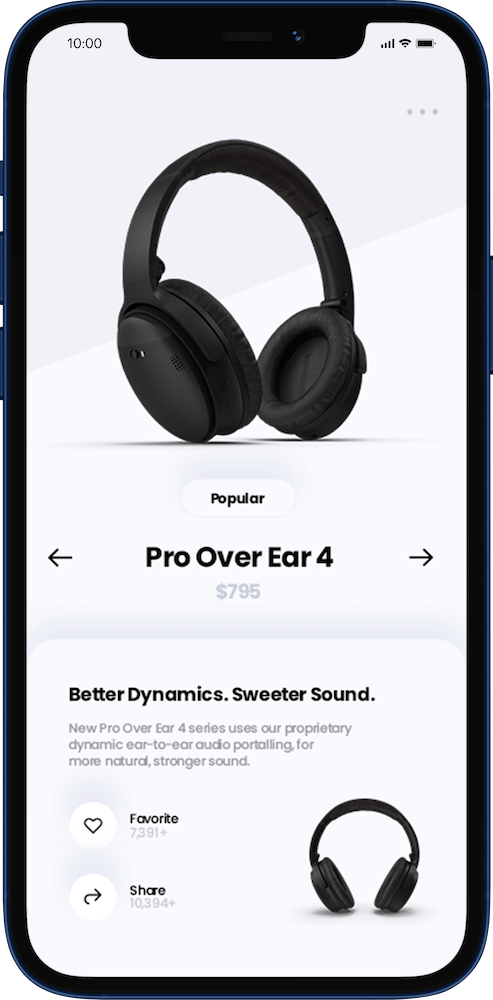
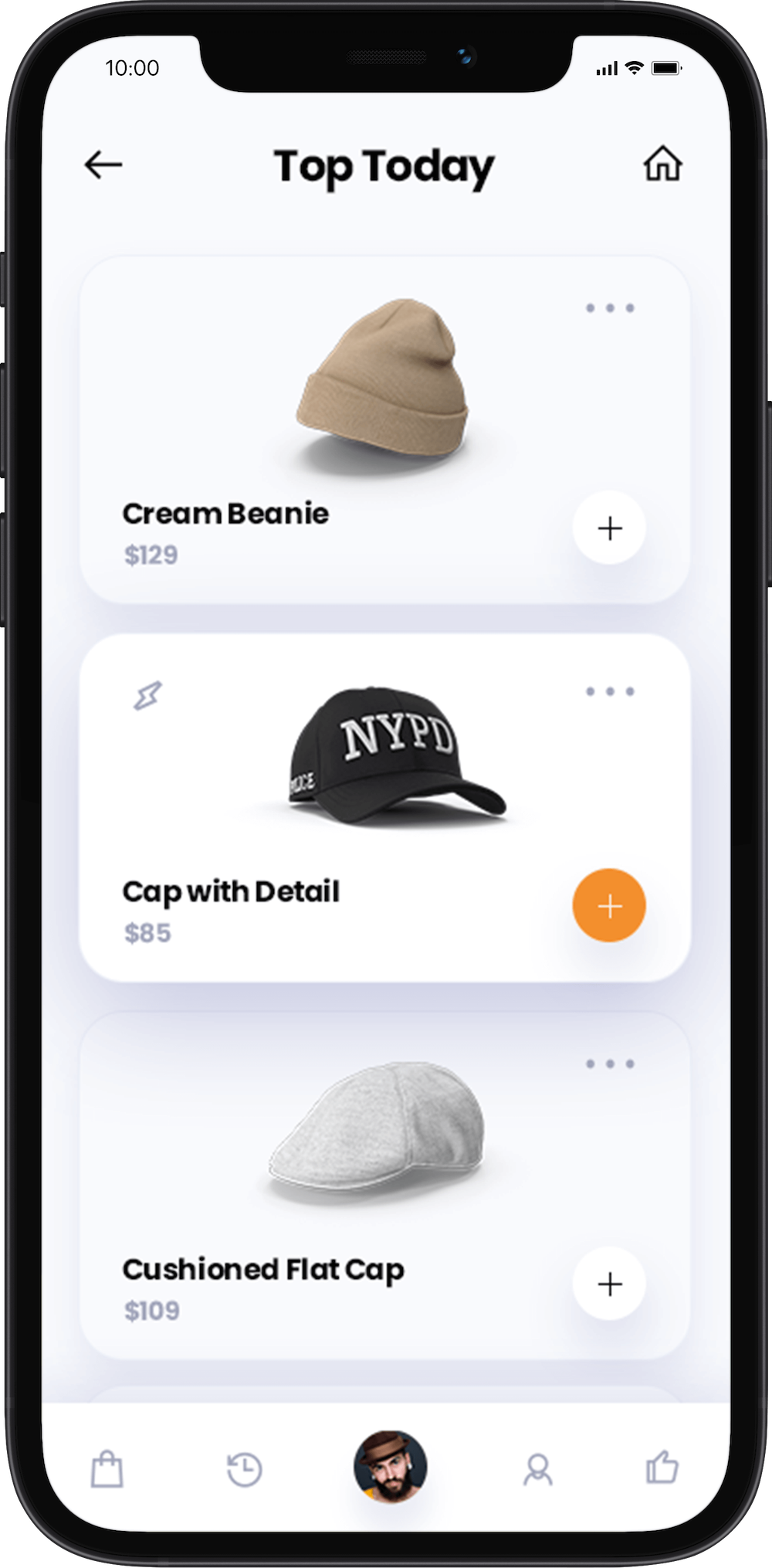
Leveraged Commerce
Specializing in Headless Shopify development for complex use cases
Our secret sauce
We solve technical challenges for our clients using Headless Shopify
By leveraging the flexible nature of Jamstack, we strive to develop solutions that are more integrated and boast higher levels of performance, alleviating existing front-and-backend restrictions.
Headless Shopify Agency
We create rich frontend experiences that deliver maximum impact.
In decoupling Shopify, your products become available as a dataset. We create winning solutions with this reclaimed flexibility.
Distribute content across multiple channels with omnichannel commerce
Integrate more advanced commerce logic
Break free from traditional frontend limitations with unrivaled flexibility
Puts control back into the hands of merchants & developers
With headless Shopify, an entirely new world of flexibility is unlocked. If you’ve struggled with the flexibility of your Shopify front end, even using a custom (or heavily customized) theme, the front end flexibility that headless Shopify affords might peak your interest.
Headless Shopify stores have JavaScript based front ends, most typically React. Remember that the most popular SSG and SSR JS frameworks (Next, Gatsby) are react based at their core.
JavaScript has proven itself a recognised winner as the front end programming language of choice. For flexibility and interactivity-it wins every time. React provides developers the power to implement rich and highly functional pages for Headless Shopify stores as standard. What’s more, the process of developing such functionality is typically significantly easier in a react-based application (Gatsby, Next, Angular, Vue, etc) than to implement within a Shopify Liquid theme. React based apps are written in JavaScript after all, so plugging in additional functionality in the same native language used for the rest of the frontend tends to be quicker and more efficient than plugging similar features into a Shopify liquid theme.
JavaScript aside, with headless Shopify you regain full and total control over the design, visuals and rendering of the storefront, and so you aren’t required to abide by any particular page structure, template structure, or in fact any other structure at all. With headless Shopify, you are afforded total design freedom, and can engineer the layout and aesthetics without limitation. Today, branding and user journeys are key components to differentiating your online offering, but additionally delivering an unrivalled experience to consumers, and as such it’s imperative to retain total control of the creation and development of this journey. Through websites and progressive web apps, the front end interface, user experience, and effective delivery of your brand story, are all equally key to this. We believe that clients should always be empowered to deliver the frontend shopping experience that a brand strives to provide. With online retail, the experience that users have whilst engaging with your store will be the difference between making and losing a sale, and so this should not be compromised on.
Whilst traditional Shopify (non headless) provides a satisfactory level of customizability through liquid templates, it’s nothing compared to the design and frontend implementation freedom that headless Shopify provides.
Headless Shopify implementations also boast many additional ways in which the experience can be further customized. In terms of user experience and functionality, you’re potentially able to build anything you dream of, within the technical limitations of your Shopify plan. For most headless stores, the Shopify Basic plan is often sufficient, though Shopify Plus provides the ability to customize the actual checkout page.
Overall, headless Shopify provides a way to customize an e-commerce storefront with superior levels of flexibility, making it possible to implement design-forward, experience-enriched web shops. This is achieved due to the fact that developers have the ability to architect and build a headless Shopify application in-line with the store’s design and functional requirements, rather than having to work with the limitations of Shopify’s liquid themes; even when they’re customized or have been built bespoke.
Omnichannel Commerce with Headless Shopify
The art of decoupling unleashes powerful new possibliities in the realm of omnichannel commerce. In decoupling Shopify, your products become available as a dataset, and you have a newfound ability to distribute this content across multiple channels such as third-party vendor platforms. The custom code that powers your headless storefront can be utilized for native apps, additional embedded applications, and more.
Greater Ownership of Your Stack with Headless Shopify
Headless Shopify stores are commonly built with React based frameworks, but through decoupling your storefront, merchants gain complete control over the technology stack that is used to deliver the headless frontend.
This means that your developer partner is able to able to advise you on the most appropriate technologies for your requirements, and as such put you in a winning position from a tech point of view.
With a number of individual layers to headless architecture, your options for caching are significantly improved compared to standard Shopify. Besides the performance level of your Shopify Liquid theme, there isn’t a whole lot you can do to improve response time on Shopify-hosted sites. In general, Shopify does a reasonable job of delivering pages at a good, reliable speed, but your options for caching aren’t configurable. With Headless Shopify, you have a variety of options available: - Browser-level caching - Caching at the Network level, for the frontend itself - Object-caching in front of your Shopify API calls These strategies allow headless storefronts to cache far more than simply assets and images, offering opportunities to further optimize pagespeed and response time.
Fundamentally, the Jamstack approach fosters high-level integrations and API-based methodology. After all, this is key to developing modern, interconnected experiences. Integrating your solution with existing CRMs and ERPs, as well as third-party platforms and tools, can provide a Headless Shopify implementation that provides far more than just a superior storefront. Marketing automation, deeper insights and analytics, and new opportunities for data processing are just some of the higher-level components that can make up an efficient Headless Shopify structure.
Fear not, Headless Shopify can still be compatible with your existing Shopify Apps. In reality, it depends entirely on the function of your Apps and whether they are responsible for enhancing backend or frontend functionality. Any Shopify Apps that are aimed at enriching the administration and management experience of your Shopify store will generally be more-or-less compatible with your new Headless setup. The same can't be said for frontend-related apps, as these wouldn’t be interacting with your new decoupled storefront. Obviously, your development partner will need to assess your existing apps to identify which will continue to enhance your Shopify administration experience well into your journey toward decoupled Jamstack architecture.
When introducing new layers into your architecture, a great deal of additional possibilities are introduced. Merchants are able to perform deeper levels of commerce logic in a layer between the frontend and Shopify’s backend. When users take actions on a headless Shopify store, developers are able to implement additional functions or logic prior to sending a request to Shopify, creating room to build higher levels of custom functionality into your application.
More on Headless Shopify

Ease of Integration
Shopify provides ease of integration with headless architecture, allowing the development of powerful and lightning fast e-commerce experiences on desktop and mobile.
Out-the-box APIs
Shopify provides vast support for headless ecommerce out-the-box, providing a large suite of out-the-box integration options, and an extensive library of additional tools and plugins.
Lower Maintenance Responsibilities
As it's fully managed, Shopify as an ecommerce backend will require no maintenance in the way of DevOps, reducing business overheads and the potential for downtime.
It's More Secure
Shopify boasts a stable and secure platform due to its commercial nature. Shopify's offering as a SaaS solution lends itself to heightened levels of security when compared to a self-maintained application.
Implementing powerful solutions for User Management & Authentication with Headless Shopify.
While Shopify does provide some ability to store user data, it’s often preferred to implement a custom authentication flow on a Headless Shopify store, given the newfound control
You can achieve better results with an alternative tool, such as Auth0, for authenticating users and storage of user data. This puts the authentication process in the hands of your store, ultimately providing more control.
If you have an existing userbase elsewhere, integrating SSO (Single Sign-on) with your existing application is also a possibility, eliminating the need to implement separate authentication for users of your Headless Shopify store.
Of course, enriching the authentication process with social login is possible, too.
Overall, authentication of users and the storage of user data can become infinitely more flexible for Headless Shopify stores. Using a secure, managed authentication solution such as Auth0, another provider, or a custom user database provides greater flexibility and control to store owners, and can potentially offer additional benefits to end users depending on the implementation.
Enjoy next-to-no setup for Headless Shopify with our proficient Headless Commerce Development Team.
For merchants, there’s practically nothing to do in order to prepare your existing Shopify site for a move to headless. There arent any complicated settings adjustments to make, besides creating and enabling some security tokens with the possible addition of webhook configuration. These tasks can be carried out by your developer or agency partner, so as a store owner there generally won’t be much required of you. By and large, how you’ve been managing your products, inventory and orders in Shopify won’t change, and you can continue to add products and adjust collections just as you would have before.
For developers, Shopify provides various APIs for consuming and sharing data to and from your Shopify store. Shopify provides multiple APIs, such as the Storefront API, GraphQL Admin API, REST Admin API, etc. Shopify's GraphQL APIs are a popular choice for headless commerce development, due to their high performance. GraphQL is a performant query language that fits well into any Headless Storefront setup.
Each of Shopify's APIs provides a different core functionality and are intended for slightly different use cases. This means that developers are empowered with the tools to create functional headless e-commerce stores with Shopify.
Additionally to the APIs provided, Shopify provides various starters (Hydrogen is Shopify's latest addition), for an improved developer experience which is particularly useful for kickstarting a project’s development.
In summary, Shopify makes it easy on both store owners and developers to utilize the strengths of headless commerce, by requiring minimal setup by merchants on the Shopify side.
Leveraging Webhooks to build more interconnected experiences with Headless Shopify.
This is great for the majority of data requirements that headless Shopify stores will need at first.
However, Shopify additionally provides a web hook functionality for developers to implement further advanced functionality into your overall build and its workflows and pipelines.
Think of Shopify webhooks as notifications. They provide the ability to receive information as-it-happens, and are sent from Shopify to your third party application, without your application requesting the information directly or continually.
This allows us to do some really cool things with headless Shopify. The most basic example would be triggering a rebuild of the storefront automatically, whenever product information is updated. This offloads an additional step, meaning that the store owner nor your developer are required to manually push updates to the site (even if it were static) in the form of rebuilding and deploying. Your Shopify developer can implement this to so that it happens automatically, each time a notification is sent by the Shopify webhook.
Webhooks allow far more complex and impressive workflows to be triggered, however.
They can be integrated within your headless Shopify setup to push data to different endpoints, including various third party applications that you may be using. Popular requests are to implement automatic notifications with a separate headless CMS, third party CRM, or even mailing lists.
Lots of powerful things can be done using the webhooks functionality, but in the context of headless Shopify, it provides an ability to automate functions and trigger external workflows upon a vast array of events that may occur within Shopify.
Faster Response Times with Headless Shopify
Headless Shopify implementations can make use of Jamstack’s well-known ability to deliver faster response times. Because of the way headless setups work, frontends will typically have the ability to load much faster for the end user. This is down to the fact that headless Shopify stores don’t require constant connections or frequent network requests to retrieve product or page data, as this is effectively “cached” during a build stage. Static site implementation is commonly used for headless Shopify stores, which involves fetching all the product data up front (during what’s known as a “build” stage), and subsequently creating the required product and category pages. When users try to load these pages, their browser returns something they already exists.
In contrast, non-headless implementations will typically build the page at the time the user requests it. In simpler terms, using static site generation for your headless Shopify store effectively “caches” all the data, allowing pages to be delivered at incredible speeds. Users are no longer waiting for a server to process requests and query a database; they are instead served with a pre-built page that includes all of the information they expect to see. This is one of the key benefits to headless setups, in that they provide the ability to prebuild and aggressively cache content where desired.
A typical use case for this is for pages that are not frequently updated, or don’t require a real-time network request to be sent. For example, a Shopify store that adds new products once a week could benefit from static site generation with a headless setup, because page content would remain the same for a whole week, until new products are added to the shop’s lineup.
You can serve pages that are largely cached for the time period between product updates or additions, and the site will rebuild itself once an update is made. This leads to the faster response times, as large amounts of the site have been prebuilt and cached ahead of the end user’s request. Of course, even with a static site implementation, some aspects of the store will always return real-time information; such as stock status, the user's cart object, and account pages such as order history.
But these requests are few and far between, contrasted to the incomparable number that would be required to constantly generate pages as a user navigates through a traditional, non headless e-commerce store. When you multiply those requests by the number of users visiting the store, it’s easy to see how this quickly racks up; ultimately demanding more of a server due to the frequency of network requests. With a headless Shopify store, you can vastly reduce the number of real-time network requests that are made by a user, by serving pages that are pregenerated and have been cached ahead of time.
Headless storefronts come with all the perks of Jamstack, which means that if you opt for real-time data fetching (perhaps your store’s content is updated too frequently for static site generation to make sense), there are still performance benefits to gain.
For a start, headless Shopify stores boast the ability to selectively define which data is fetched at runtime (real time data fetching as the user browses the site), and which data is fetched at build time (in order to pre generate the page so it can be served without the requirement to fetch the data live). So even if your headless approach does not make use of static site generation on the whole, you’re able to reduce overall runtime network requests by selectively storing some of that data from the earlier build process. That’s still going to know a difference to overall show performance and response times.
Furthermore, though, various frameworks utilized for headless Shopify development support pre-fetching of data during runtime. Gatsby is a good example here. Gatsby has long supported pre-fetching: It does this by identifying which links on a page the user hovers over, and starts fetching the data before the user even clicks the link. This activity is imperceivable to the end user, meaning that they aren’t even aware it’s happening. This is a real winner when it comes to response times, as the page subsequently loads significantly faster once the user actually clicks. This is a game changer for user experience, reducing perceived load times.
The Jamstack approach overall lends itself to improved response times and more aggressive cacheability, so it’s likely that your Headless Shopify Developer will be utilising additional techniques besides prefetching data and optimising build time vs runtime data fetching.
One such example is gatsbys impressive image compression and lazy loading (blur up) functionality. For headless Shopify sites that utilize build time data fetching, images can be downloaded and optimized through compression, and served to the end user through Gatsby's image plugin. Not only does this reduce response time through lazy loading of the image, it means that the file is served by the same origin as the storefront itself, (rather than using the Shopify URL for the original image), and this can reduce the time lost to the additional DNS lookup. Factor in a headless CMS as well, and you could be losing time for each additional DNS lookup.
It’s good to note that it’s not always as straight forward as this, as browsers are known for also rate limiting the number of simultaneous requests to the same host, which effectively throttles the overall download speed of these resources required to serve the page, but it’s good practice to trial the various options for image/asset compression to determine which provides the optimal overall download speed for key pages.
Overall, it’s easy to see how headless architecture can utilize multiple techniques to optimize page speed for the end user, providing superior developer tooling for improving the user experience.
Let's chat
Discover what we can do for you
We are Cocoon, a multitalented digital media agency and web development collective based in London. We develop cutting-edge solutions that expertly cater to the demanding needs of tomorrow.
Let's talk Headless Shopify
We help businesses create stronger impact through powerful, high-performance applications. Case studies available on request.
Free consultation

